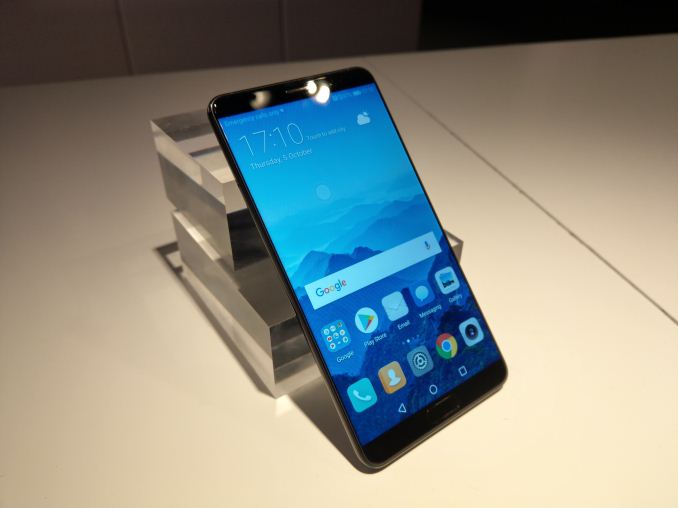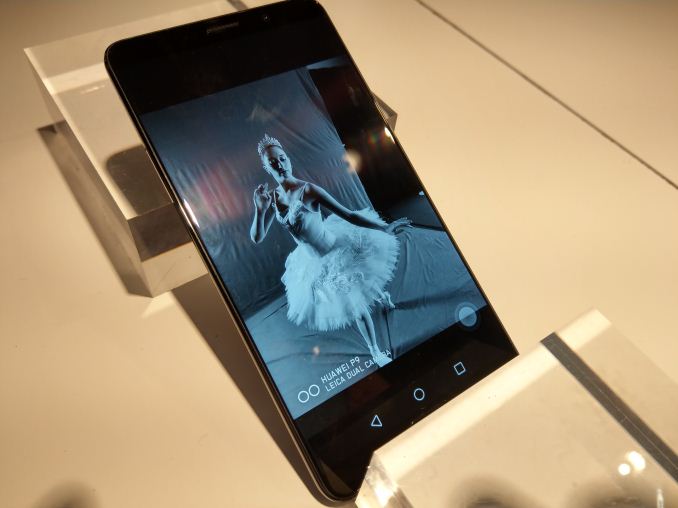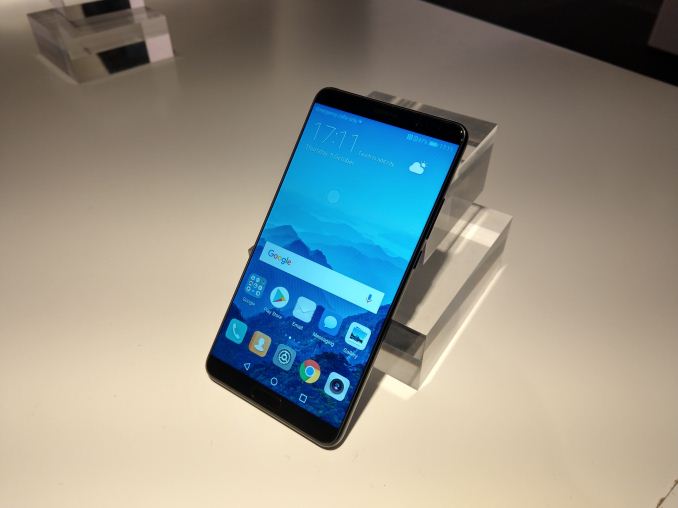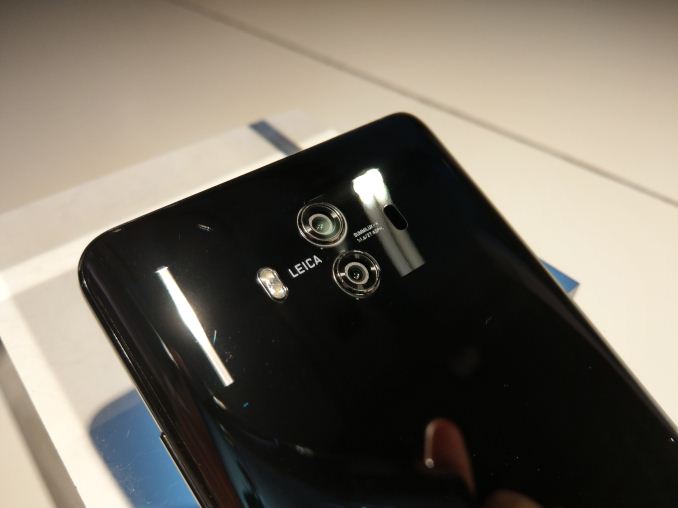Hands-on & More With Huawei's Mate 10 and Mate 10 Pro: Kirin 970 Meets Artificial Intelligence
by Ian Cutress on October 16, 2017 9:00 AM EST
This morning Huawei is taking the wraps off of their latest generation flagship smartphone, the Mate 10 series. Powered by subsidiary HiSilicon’s Kirin 970 SoC, the new phones are a mix of something old and something new for the company. With a design that is not simply a carbon copy of the earlier Mate phones but is still very much a traditional smartphone, Huawei’s latest flagships are a mix of old and new; tried and true paired with the cutting edge. It’s an interesting balancing act, and one that, if consumers agree, will further bolster Huawei’s success in the international smartphone market while at the same time pushing a nascent technology to the forefront of the mobile industry.
That technology is, of course, artificial intelligence, which has become the buzzword for the latter half of this decade in the world of technology. Long a lofty goal of computer science – if not perhaps its holy grail – recent advancements in the field have opened the door to new methods and new applications. And while this era of neural networking-driven AI is not by any means producing devices that actually think like a human, even this weak form of AI is, in the right use cases, far more capable than anything that has come before it.
Of course, the usefulness of having neural networking hardware is only as good as the appications that run on it, and in these still-early days of the field, the industry as a whole is trying to figure out what those applications should be. Having a self-driving car or a smart NPC in a video game makes sense, but applying it to a smartphone is confusing at first. Huawei announced that its new Kirin 970 chipset had dedicated silicon for running artificial intelligence networks, and the Mate 10 series is going to be the first device running this chip. Today, they announced the smartphones and unveiled the features.
The Mate 10, Mate 10 Pro, and Mate 10 Porsche Design
The devices themselves are part of Huawei’s yearly cadence with the Mate series. Every year at around this time we see a new smartphone SoC and the first two devices that power it: the Mate and the Mate Pro. Both the hardware and the design are meant to be iterative – Huawei’s HiSilicon division takes the ‘best’ IP available from ARM to develop the processor, and the design team takes cues from the industry as to what will be the next statement in aesthetics.
One of the big trends for 2017 (and moving into 2018) is full-screen display technology. In previous years, manufacturers have often quoted ‘screen-to-body’ ratios in order to show how much of the face of the device is taken up by screen, but it is this year that has started to push the boundaries on this aspect. Arguably devices such as Xiaomi’s MI MIX range were instrumental in pushing this, but the upside is more screen for everyone or the same sized screen in smaller devices. Huawei is pushing the screen with its ‘FullView Display’ (the marketing name for it).
The Mate 10 comes with a 5.9-inch FullView display, using a glass front for the 2560x1440 LCD display, coming in at 499 pixels per inch. Huawei is quoting panels capable of a 1500:1 contrast ratio, while the color space is listed at a less-than-useful metric of 96% NTSC.
The Mate 10 Pro (and Porsche Design) are slightly bigger with their 6.0-inch displays, although this time it comes with an OLED screen at 2160x1080 resolution. This is a lower pixel density (402 ppi) and resolution compared to the regular Mate 10, but is rated at 112% NTSC and 7000:1 contrast. The smaller resolution and use of OLED might also assist in battery life as well, and overall the unit is lighter than the Mate 10.
Neither device goes to the extreme with the display completely covering the front, as it requires certain methods of moving the internals such as the camera (on the bottom on the MI MIX, on the notch on the iPhone X) as well as how to implement fingerprint technology. One of the biggest design deviations for this generation of Mate devices is that the Mate 10 regular edition now has the fingerprint sensor on the front of the phone, rather than the rear. In my eyes this is a pretty big jump, given that the Mate S, the Mate 8 and the Mate 9 regular editions all had fingerprint sensors on the rear. The Mate 10 Pro, by contrast, does keep the sensor on the rear.

This pre-production unit hasn't updated the logo
There is no difference between each of the devices for the SoC inside, with each device getting the full-fat Kirin 970. This means four ARM Cortex A73 cores at 2.36 GHz and four ARM Cortex A53 cores at 1.8 GHz. These are paired with Mali G72 MP12 graphics (at an unstated frequency), the i7 sensor processor, and Huawei’s new Neural Processing Unit, or NPU (more on this later). All of the units will use Huawei’s latest Category 18 integrated LTE modem, capable of 1.2 Gbps download using 4x4 MIMO on 3-carrier aggregation with 256-QAM. Each device supports dual-SIM LTE concurrently (along with dual-SIM VoLTE), although this limits downloads to Category 16. Uploads are at Category 13.
Only one option for memory and storage is available with the Mate 10, with Huawei settling on 4GB of LPDDR4X DRAM and 64GB of NAND for storage, with microSD card support further augmenting that, though by taking one of the SIM slots. For some reason it says limited to 256GB, though I will ask about the new 400GB microSD cards.
The Mate 10 Pro will be available in 4GB/64GB and 6GB/128GB versions, although the latter will be dependent on region – we are told around 20 countries are on the initial list. The Mate 10 Porsche Design model will be only available in a 6GB/256GB configuration, similar to last year.
All the devices come with the typical dual-band 802.11ac Wi-Fi support, extending to BT4.2, and will include NFC. All three devices use USB Type-C, but only the base model has a headphone jack. Despite the Mate 10 Pro/PD being physically bigger than the standard Mate 10, all three devices use a 4000 mAh battery which is TUV certified for SuperCharge. That in itself is fairly large for a modern flagship, which is perhaps a benefit of only a few smartphone companies now competing in the ‘under 7mm’ metric for thickness. The Huawei devices come in at 8.2mm and 7.9mm for that.
The cameras on all the devices are identical as well, with Huawei further leveraging the Leica band cooperation. The front camera is an 8MP f/2.0 unit, while the rear camera does something a little bit different this time around. The dual camera is vertical, like the Mate 10, but without the extra protective shroud around the lenses. The cameras are similar 12MP RGB and 20MP monochrome, as found on last year’s flagships, although this time they are both f/1.6 and using Leica SUMMILUX-H lenses with AI-powered bokeh. This allows for ‘2x hybrid zoom’ (which we established last year is more like a crop than a zoom), but the phones also have 4-way focus (PDAF, CAF, Laser, Depth) and have a dual LED flash.
Huawei will launch these devices on Android 8, using their custom implementation called EMUI. Last generation was EMUI 5, and this generation will be called EMUI 8. The reason for the jump is two-fold: the number 8 is a highly positive number in Chinese culture, but also it addresses some comments as to why the EMUI numbering system was ‘behind’ the Android version. Huawei intends to keep EMUI’s version number paired with the Android version for the foreseeable future.
| Huawei Mate 10 Series | |||
| Mate 10 | Mate 10 Pro | Mate 10 Porsche Design | |
| SoC | HiSilicon Kirin 970 4x Cortex-A53 @ 1.84GHz 4x Cortex-A73 @ 2.36GHz ARM Mali-G72 MP12 @ ? |
||
| Display | 5.9-inch 2560x1440 RGBW |
6.0-inch 2160x1080 OLED |
|
| Dimensions | 150.5 x 77.8 x 8.2 mm 186 grams |
154.2 x 74.5 x 7.9 mm 178 g |
|
| RAM | 4 GB LPDDR4X-1833 |
4/6 GB LPDDR4X-1833 |
6 GB LPDDR4X-1833 |
| NAND | 64 GB (UFS 2.1) + microSD |
64/128 GB (UFS 2.1) | 256 GB (UFS 2.1) |
| IP Rating | IP53 | IP67 | |
| Battery | 4000 mAh (15.28 Wh) non-replaceable |
||
| Front Camera | 8MP, 1/2.0" | ||
| Rear Camera | Color: 12MP, 1/1.6 Monochrome: 20MP, f/1.6 PDAF + Laser AF + Contrast AF + Depth, OIS, HDR, dual-tone LED flash |
||
| Modem | HiSilicon LTE (Integrated) 2G / 3G / 4G LTE Category 18/16 Download Category 13 Upload |
||
| SIM Size | 2x NanoSIM (dual standby) | ||
| Wireless | 802.11a/b/g/n/ac, BT 4.2 LE, NFC, IrLED, GPS/Glonass/Galileo/BDS | ||
| Connectivity | USB 2.0 Type-C, 3.5mm headset | ||
| Fingerprint Sensor | Front | Rear | |
| Launch OS | Android 8.0 with EMUI 8.0 | ||
| Launch Price | 699 Euro (4/64) | 799 Euro (6/128) | 1349 Euro |
| US Price | ~$549-$599 | ~$649-$699 ~$749-$799 |
Some* fingers *may be more than some |
Pricing for the Mate 10 and Mate 10 Pro is likely to mirror the pricing for last year’s flagships. This means around $549-$599 for the regular edition and $649-$699 for the Pro. Add in another $100 for the higher capacity model, and probably another $250-$400 for the Porsche Design version. (Updated in table)


















103 Comments
View All Comments
cfenton - Monday, October 16, 2017 - link
The only thing interesting about the Kirin 970 is the AI processor, and they can't provide even a single interesting app that uses it. I'm sure there will eventually be cool uses for it, but probably not before Huawei's next phone comes out. That's not much of a selling feature.Valantar - Monday, October 16, 2017 - link
I might sound like an old fart here (29 going on 70?), but I just don't get all this AI hype. If the neural network isn't trained through use on the phone, how is this different from any application doing the same job through conventional means? The bar for calling something AI seems to be precariously low. Is it AI if the app/algorithm in question was written by an AI, and it never changes or adapts? I would say no, not unless the output itself is reactive and flexible and adapts over time. After all, any algorithm adapts to new input - that's what they do. If it doesn't learn over time, there's nothing making it even remotely "intelligent". Now, I'm probably way over my head in terms of both programming and hardware understanding, but isn't this just a fancy new marketing term for highly specialized parallel workloads? I.e. something a GPU can do with minor (if any) modifications? If so: what's intelligent about it?If all AI can do for consumers is a slightly better job at applying preset filters to your photos than the current algorithms do, I'm glad to pass on that. Thanks, but no thanks.
serendip - Monday, October 16, 2017 - link
I wonder what the AI is for. My usual day isn't very usual other than the coffee, weather check and commute, and the phone-related changes are all taken care of by Tasker on Android. I don't need an AI to preempt my actions by doing the opposite of what I want.jospoortvliet - Tuesday, October 17, 2017 - link
A static non learning AI neural network can do things a normal core can do (e.g. face recognition and object following, translating, voice recognition or generation etc) far more efficient. Just like there is no need to include a GPU unless ypubcare about efficiency... the learning aspect is not core to AI as most networks get trained on super computers and then just used.Valantar - Tuesday, October 17, 2017 - link
So in other words, the term AI is utterly meaningless. If the algorithm doing face recognition on my phone is generated by training a neural network rather than being written by a programmer, how does this make it "intelligent" in any way? An algorithm is an algorithm, no matter its origins. Sure, it might be a /better/ algorithm, but calling that "intelligence" is nothing more than marketing fluff. I suppose we could call it "AI-originated" or some such, but again: what value does that bring to the table?philehidiot - Thursday, October 19, 2017 - link
I'm totally with you on this. The AI thing just seems to be a load of marketing bollocks. It may be useful for huge datasets where you want to determine patterns but most of the stuff we see as "AI" is just a load of IF, AND and OR statements. Alexa is a prime example - you have to get the phrasing just right for your question and even then it often struggles. It's the voice assistant equivalent of typing commands in DOS - get one word wrong and it won't work. To me this isn't intelligent, it's voice recognition attached to a list of "IFTTT" statements. Maybe I'm just old and stupid but I made stuff like this as a kid using BASIC which identified key words or phrases being typed and responded appropriately.... or inappropriately given I was a teenager and enjoyed giving out abuse using "AI".FreidoNumeroUno - Saturday, October 21, 2017 - link
I think the same. AI really sounds like a hype in mobile industry. Its possible apple or some other companies research on AI. But that does not mean they can make any notable changes to the apps or architecture that can actually "learn" unless predefined in the program itself, which makes it just another program with minor changes.Apple's AI claims are laughable btw
varase - Sunday, November 19, 2017 - link
My guess is a little bird told Huawei that Apple was including a neural processor capable of 600 billion ops/second, and Huawei decided to put in one capable of a trillion ops/second to give them bragging rights (if anyone remembers the snark with which they announced the 970 as the iPhone 8 killer [the iPhone X name at the time in the rumor mills]).They had to have compared the 970's CPU and GPU against the A10 and they certainly don't warrant that level of snark - or any snark at all really.
Unfortunately for them, they had no idea what was coming from the A11 as this is one aspect of Apple's development Apple could actually keep under wraps (since it's entirely in-house).
Valantar - Monday, October 16, 2017 - link
RGBW LCD? There goes any hope that Huawei should start caring about colour accuracy, then. Not that my Oneplus 3T needs replacement any time soon, but this is disappointing (and what kept me from getting a Huawei phone last time around - that, and the UX).Oh, and that chip is gigantic for a phone SoC. Wow.
Andrei Frumusanu - Monday, October 16, 2017 - link
RGBW has absolutely no effect on colour accuracy.